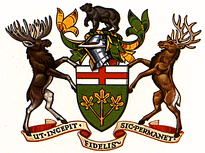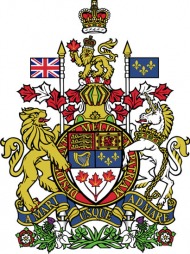|
Confused??Don't panic! Click on the file at left (Our Country Our Parliament) for a great booklet created by the Parliament of Canada to help explain itself to the citizens of this country. Highly visual with language that is easy to understand, this reasource might help make things a little clearer for you. Of course, don't hesitate to ask your teacher for help.
| ||||||
Orders of Government
| Orders of Government Group Brainstorm.pdf | |
| File Size: | 169 kb |
| File Type: | |
| Which Order of Government? | |
| File Size: | 666 kb |
| File Type: | |
The Closest Order to you - MUNICIPAL

Coat of Arms of Hamilton
Citizens of counties, towns, and cities elect representatives to be responsible for municipal, or local, government. The elected representatives of counties and other rural bodies, such as improvement districts, are called reeves (the heads) and councilors. People elected to run towns and cities are called mayors (the heads) and aldermen and/or councilors. In both cases, the group together is called a council, and by "local government," we mean the various councils. Councilors may belong to political parties, but they do not represent a party when they run for election. Also, unlike the Prime Ministers or Premiers, reeves and mayors are elected directly to their positions.
Each provincial Legislature decides what local governments are responsible for. Usually they are given authority in matters such as local fire and police services, libraries, transportation within the municipality or county, local health issues, pest control, and so on. Municipal governments may pass laws governing these areas, and these laws are called bylaws. (Alberta Online Dictionary)
Each provincial Legislature decides what local governments are responsible for. Usually they are given authority in matters such as local fire and police services, libraries, transportation within the municipality or county, local health issues, pest control, and so on. Municipal governments may pass laws governing these areas, and these laws are called bylaws. (Alberta Online Dictionary)
|
|

Coat of Arms of Ontario
Government in the provincial order consists of the Premier and Cabinet Ministers. Like their federal counterparts, the Premier and ministers are almost always from the same political party, the one with the most elected members in the Legislative Assembly.
The premier, cabinet ministers, and all other elected members together make up the Legislative Assembly and are called Members of the Provincial Parliament or MPPs (i.e. Ted McMeekin), while the Legislature is the Legislative Assembly together with the lieutenant governor (who represents The Queen). The provinces' areas of responsibility, defined in the Constitution Act, 1867, include health, child welfare, municipal government, highways, labour, property and civil rights, and education.
The premier, cabinet ministers, and all other elected members together make up the Legislative Assembly and are called Members of the Provincial Parliament or MPPs (i.e. Ted McMeekin), while the Legislature is the Legislative Assembly together with the lieutenant governor (who represents The Queen). The provinces' areas of responsibility, defined in the Constitution Act, 1867, include health, child welfare, municipal government, highways, labour, property and civil rights, and education.
Alternative Assignment - Creating your own Private Members' Bill
| Creating your own Provincial Law | |
| File Size: | 2354 kb |
| File Type: | |
Government of Canada - FEDERAL

Coat of Arms of Canada
In the federal order, the government consists of the Prime Minister and cabinet ministers. The Prime Minister and cabinet are always members of the same political party, usually the one that has the most members in the House of Commons, unless a Minority Government is currently in power.
In the federal order, the government is part of an institution called Parliament. Parliament consists of the Queen, represented by the governor general, and two Houses, the House of Commons (the "lower House") and the Senate (the "upper House"). In turn, the House of Commons consists of all Members of Parliament - MPs - while the Senate is made up of Senators appointed by the Queen on the advice of the prime minister. Parliament's areas of responsibility under our Constitution include citizenship, foreign policy, national defense, currency, banking, and the postal service.
In the federal order, the government is part of an institution called Parliament. Parliament consists of the Queen, represented by the governor general, and two Houses, the House of Commons (the "lower House") and the Senate (the "upper House"). In turn, the House of Commons consists of all Members of Parliament - MPs - while the Senate is made up of Senators appointed by the Queen on the advice of the prime minister. Parliament's areas of responsibility under our Constitution include citizenship, foreign policy, national defense, currency, banking, and the postal service.
Elections - The Vote and Political Parties in Canada
| Where do you sit on the political spectrum?.pdf | |
| File Size: | 249 kb |
| File Type: | |
Optional Activity: Bowling for Columbine and the Political Spectrum
Bowling for Columbine is an excellent way to review concepts of bias, political and personal ideologies and their impact on poltics.
| Bowling for Columbine.pdf | |
| File Size: | 208 kb |
| File Type: | |
The Election Campaign
|
Perceptions of politics: Lois battles Adam West for the mayor's office
|
|
Can you find some clues that tell you about Barack Obama and John McCain's political ideologies?
Where would you put them on the political spectrum? |
|
What is an attack ad? The following campaign against Prime Minister Jean Chretien was infamous during 1993 - do you think there is any value to such a strategy?
|
|
2008 vice-presidential candidate Sarah Palin runs into a problem when she can't name a newspaper she reads
|
Note: The Vote in Canada
Download the note below to learn about what happens during a Federal election:
| First Past the Post.pdf | |
| File Size: | 103 kb |
| File Type: | |
| The Vote Note | |
| File Size: | 172 kb |
| File Type: | |
Videos: Different ways of voting - Is our system the best?
Assignment: Political Party Assignment
Using the websites located in the "Interesting Websites" section of this website (Under the heading "Political Parties") complete the following handout:
| Political Party.pdf | |
| File Size: | 597 kb |
| File Type: | |
Assignment: Classroom Election
Students are asked to create their own political parties, holding a mock election in the classroom over six days.
| Create Your Own Political Party.pdf | |
| File Size: | 89 kb |
| File Type: | |
Ballots: Canada, New Zealand, Angola
United States, Congo, Barbados
United States, Congo, Barbados
